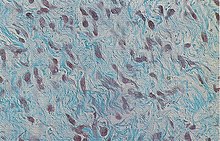Nodular fasciitis
| Classification according to ICD-10 | |
|---|---|
| M72.4 | Pseudosarcomatous fibromatosis, including nodular fasciitis |
| ICD-10 online (WHO version 2019) | |
The fasciitis Nodular among the most common fibroproliferative diseases, but is largely unknown. It is probably reactive in nature and stops spontaneously.
pathology
The "nodes" that almost always grow individually are not tumors , but tumor-like fibroblastic lesions of unknown etiology . Local violence and unspecific inflammation can trigger the process. It is found primarily on the upper extremities of young adults between the ages of 20 and 35. It is not the surgical therapy that is problematic , but the histological differential diagnosis; because sarcoma-like findings can lead to misdiagnosis and thus to inappropriate therapeutic decisions ( radiation therapy ). Of 55 cases, 20 were found to be sarcomaand only 10 correctly diagnosed as nodular fasciitis. Hardly any soft tissue lesion causes the pathologist as much difficulty as this disease. The differentiation from fibromatosis , fibrosarcoma and especially malignant fibrous histiocytoma can be extremely difficult.
literature
- D. Stiller, D. Katenkamp: The nodular fasciitis . In: Zentralblatt für Chirurgie. 98 (1973), pp. 885-888.
- JR Döhler , B. Helbig: Nodular fasciitis in sport shooters . In: Journal of Orthopedics. 123: 76-78 (1985). Abstract (Thieme)
Web links
- Fasciitis nodularis pseudosarcomatosa (online encyclopedia of dermatology, venereology, allergology and environmental medicine)
- KA Grötz, B. Al-Nawas, U. Bettendorf: Fasciitis nodularis pseudosarcomatosa . In: Oral and maxillofacial surgery . tape 8 , no. 1 , 2004, p. 41-45 , doi : 10.1007 / s10006-003-0513-9 .
Individual evidence
- ^ EB Price, WM Silliphant, R. Shuman: Nodular fasciitis . In: American Journal of Clinical Pathology. 35 (1961), p. 122.
